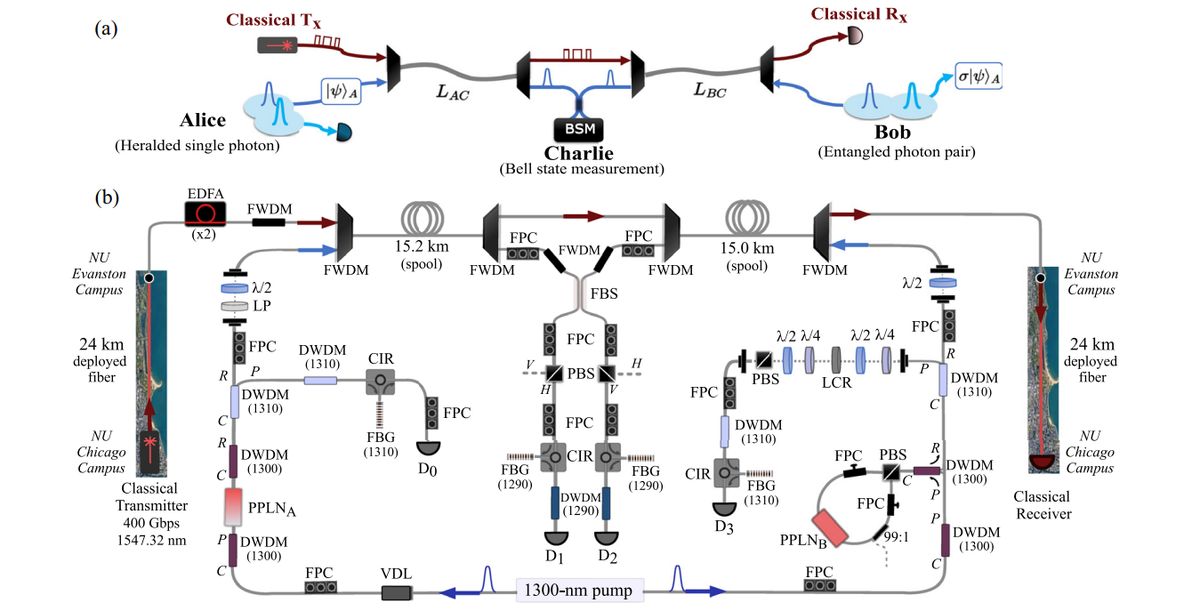and the distribution of digital products.
Quantum teleportation over the internet? Northwestern just made it happen

Northwestern University engineers have achieved the first demonstration of quantum teleportation over fiber optic cables transporting conventional Internet data. This breakthrough, led by Professor Prem Kumar, combines quantum and classical communications seamlessly using existing infrastructure.
Northwestern engineers demonstrate quantum teleportation over fiber opticsThe study, published in the journal Optica, reveals that quantum teleportation can occur without the need for dedicated setups for quantum communication. Kumar explained that the work demonstrates how quantum networks and classical networks can share the same fiber optic framework. “It opens the door to pushing quantum communications to the next level,” he stated.
Quantum teleportation relies on quantum entanglement, a phenomenon where two particles become interconnected, allowing information transfer without physical transmission. This method enables ultra-secure communication, as it does not require data to traverse the distance between sender and receiver. Instead, it utilizes entangled particles to relay information through their shared state, regardless of distance.
To realize this feat, Kumar and his team overcame challenges associated with the entangled particles being washed out by other Internet traffic. They identified a less congested wavelength of 1290 nanometers, distinct from the heavily trafficked C-band at 1547 nanometers. By expertly studying light scattering in fiber optic cables, the researchers optimized conditions to minimize interference from overlapping signals.
 (Image: Optica)
(Image: Optica)
Through a setup involving a 30.2-kilometer fiber optic cable, the team simultaneously transmitted quantum information alongside 400 Gbps Internet traffic. They performed quantum measurements midway and verified that the quantum state was successfully teleported, proving the durability of the entanglement amid busy traffic.
“This ability to send information without direct transmission opens the door for even more advanced quantum applications being performed without dedicated fiber,” said Jordan Thomas, a Ph.D. candidate and lead author of the study. While this experiment served primarily as proof of concept, future innovations may lead to practical quantum communication applications.
How Quantum Computing stock (QUBT) jumped 300%
Next steps for the team include extending the experimental range and employing multiple pairs of entangled photons—an approach called entanglement swapping. This technique may enhance quantum networking capabilities while maintaining the benefits of existing infrastructures. Their ambitions extend to testing with ground-level optical cables, emphasizing the feasibility of these quantum technologies in real-world scenarios.
One notable aspect of this progress is its potential reflection on security measures in communications, offering a method to transmit data impervious to interception. Kumar emphasized a critical consideration: “If we choose the wavelengths properly, we won’t have to build a new infrastructure. Classical communications and quantum communications can coexist.”
This achievement, while significant, still requires further research and refinement before it can translate into practical applications. As quantum technologies continue to evolve, the implications of this work could redefine the landscape of secure communication. The study has placed a substantial spotlight on the ongoing viability of merging quantum and classical communications within the established frameworks already in place.
Featured image credit: Compare Fibre/Unsplash
- Home
- About Us
- Write For Us / Submit Content
- Advertising And Affiliates
- Feeds And Syndication
- Contact Us
- Login
- Privacy
All Rights Reserved. Copyright , Central Coast Communications, Inc.